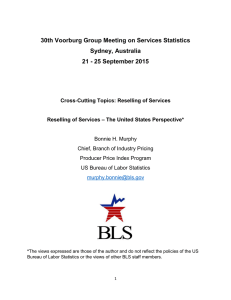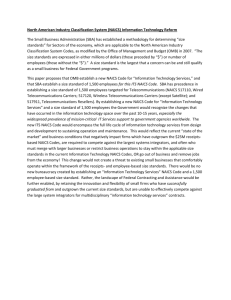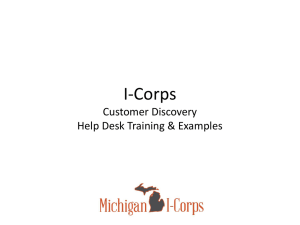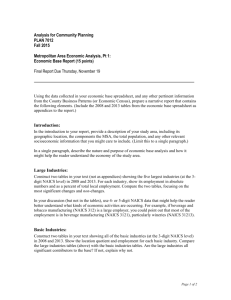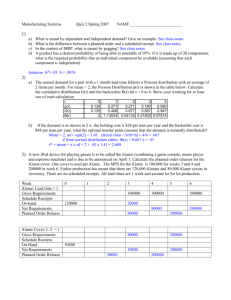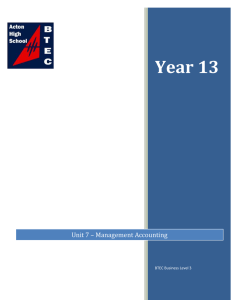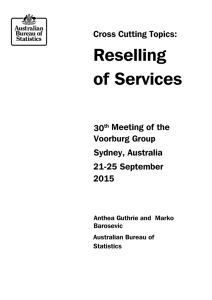Reselling of Services - The US Perspective Bonnie Murphy
advertisement
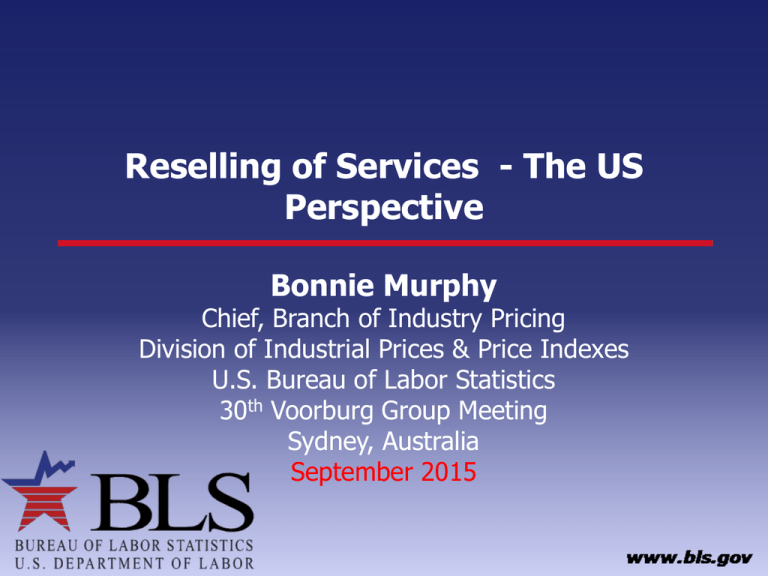
Reselling of Services - The US Perspective Bonnie Murphy Chief, Branch of Industry Pricing Division of Industrial Prices & Price Indexes U.S. Bureau of Labor Statistics 30th Voorburg Group Meeting Sydney, Australia September 2015 Principal ? Transformation ? Inventory risk ? Agent ? Reselling ? ? Credit risk 2 Topics Decision process Classification and prevalence SPPI and turnover examples National Accounts 3 Identifying Reselling Services Step 1 – Principal or Agent decision Principal – Obligated to perform service – Transforms any services provided by third party (subcontractor) • Bundling of services may indicate transformation – Likely assumes inventory or credit risk Agent – Service performed is creating market for buyer and seller (bringing them together) • No transformation of service • No credit or inventory risk – No discretion in establishing prices for the contracted third party’s services – Prices measured in the form of fees, commissions, or margins (i.e. net) 4 Identifying Reselling Services (continued) Step 2 – Agent service or reselling? Agent service • Buyer and seller brought together • No services bought or resold • Measured as fee or commission Reselling service – Service is purchased and then resold without transformation – Measured as margin 5 Classification of Reselling Activities Generally, ISIC and NAICS classify reselling of a service in the industry of the service that is being resold Reselling is prevalent in transportation related industries (e.g. travel agencies), telecommunications industries (both wired and wireless), and industries where “virtual” products are provided over the internet. Electronic tickets for events, vouchers for restaurants, and prepaid gift cards are common “resold” products NAICS identifies a few industries specifically characterized by reselling services Telecommunications resellers Freight Transportation Arrangement (freight forwarding) 6 Classification and Turnover Inconsistency in classification of reselling of goods vs. reselling of services Goods bought and resold by establishments classified in any sector other than trade are measured as miscellaneous secondary activity (gross sales) Best practice suggestion: Capture “cost of resold goods” for all industries so that margins can be calculated Resold Services are classified as a primary activity in the service industry where the ultimate resold service is provided (measured as gross receipts as well) Turnover measurement issue can arise if an industry includes both principal service provider services (measured as gross) and resold services. If only a single gross operating receipts turnover measure is captured for the industry, the resold services are over represented Best practice suggestion: Capture “Cost of services sold” (in the same way the cost of goods sold is captured for retail trade) For discussion: Are establishments able to distinguish between costs for subcontracted services 7 and resold services? Example NAICS 488510 - Freight Forwarding Companies arrange for the transportation of freight (they do not actually transport the cargo themselves) SPPI Arrange to have cargo shipped on behalf of carrier and take legal possession during arrangement Pay transport charges as cost of doing business Assume financial responsibility for goods and therefore, have inventory risk (cargo liability insurance required for ocean freight forwarders and for some other modes) Measured as margin or spread (sometimes commission) Turnover for Freight Transportation Arrangement at the 6-digit industry level is net operating revenues Shipping agents and brokers are directed to include commissions, not gross charges Freight forwarders are instructed to report the difference between the gross charges and the amounts paid to other transportation companies (margin) 8 Example NAICS 517911-Telecommunications Resellers Purchase access and network capacity from owners and operators of telecommunications networks and resell both wired and wireless telecommunications services to businesses and households SPPI - Not covered Turnover - Separate means of collection of “net receipts” for Telecommunications Resellers is not available Turnover for Telecommunications industries (3-digit NAICS) is captured as gross receipts in Economic Census Services Annual Survey captures an expense category for “access charges” (at the 3digit level) that could be subtracted from the gross receipts captured in the Economic Census and net revenues could be determined for Telecommunications Resellers if it were captured at the 6-digit NAICS industry level 9 Example NAICS 561510 – Travel Agencies Online travel agencies – merchant model 10 Example Online Travel Agency – Merchant Model SPPI Online travel agency gains access to (does not purchase) a group of hotel rooms at a discounted price A markup is applied and the travel agency sells the rooms to consumers No inventory risk if rooms are unsold, they revert back to the hotel Price collected for SPPI is the difference between the price the consumer pays and the discounted price the travel agency paid (i.e. margin) Turnover for Travel agencies appropriately measured as net receipts at the 6-digit NAICS industry level 11 SPPI Example Gift Cards Reselling of both wired and wireless telecommunications carriers’ minutes at a Convenience Store Telecommunications Carrier “sells” minutes to a convenience store that then resells them at the carriers’ price through pre-paid storedvalue cards (prepaid cards with monetary values redeemable for goods, services, and/or cash) SPPI measures the transaction as the net fee received by the convenience store for acting as the “agent” in arranging for the sale of the minutes Convenience store assumes no risk Collected as a secondary activity of the trade industry 12 National Accounts The 2008 System of National Accounts, the Balance of Payments Manual sixth edition (BPM6) and the Manual on Statistics of International Trade in Services 2010 (MSITS 2010)) contain recommendations that agent services transactions that cross country borders should be recorded gross OECD Draft of Chapter 5 of the Impact of Globalization chapter: Suggests that the gross recording of flows from the perspective of the arranger is not appropriate given that this service is not provided by the arranger to the client Recommends an additional presentation of data on a net basis for countries for which this phenomenon is important If recording of these “arrangement” services as net were adopted, it may help to eliminate any current over inflation of current trade in services in the country of the arranger 13 National Accounts Examples Example 1 - U.S. entity purchases software development services from a firm in Ireland for $100 and then immediately sells those services to a firm in Germany for $200. Ideally captured as a US import of a service for $100 and a corresponding export of a service for $200 In practice, the Bureau of Economic Analysis (BEA) would pick up the gross flows in the national accounts and would not be able to identify them as related so the “reselling service” could not be identified Example 2 (more common)- The US entity is an agent and does not purchase the services, rather, connects the Irish software firm with the German firm and then collects a $100 fee from the Irish firm. BEA records the $100 fee as an export This “brokering” fee is considered a foreign transaction for the U.S. 14 Summary Best practice suggestion: The treatment of resold services should be analogous to the treatment of resold goods (i.e. measured as margin) Examples illustrate that reselling is difficult to define for services Purchase or possession of the service before reselling is not necessarily required when defining a resold service Debate as to whether inventory risk is required to define a resold service The methodology for collection of turnover and the capture of prices for the SPPI for reselling of services should be consistent to ensure accurate representation in the National Accounts 15 Contact Information Bonnie Murphy Producer Price Index Program murphy.bonnie@bls.gov (202) 691-7689 www.bls.gov/ppi

